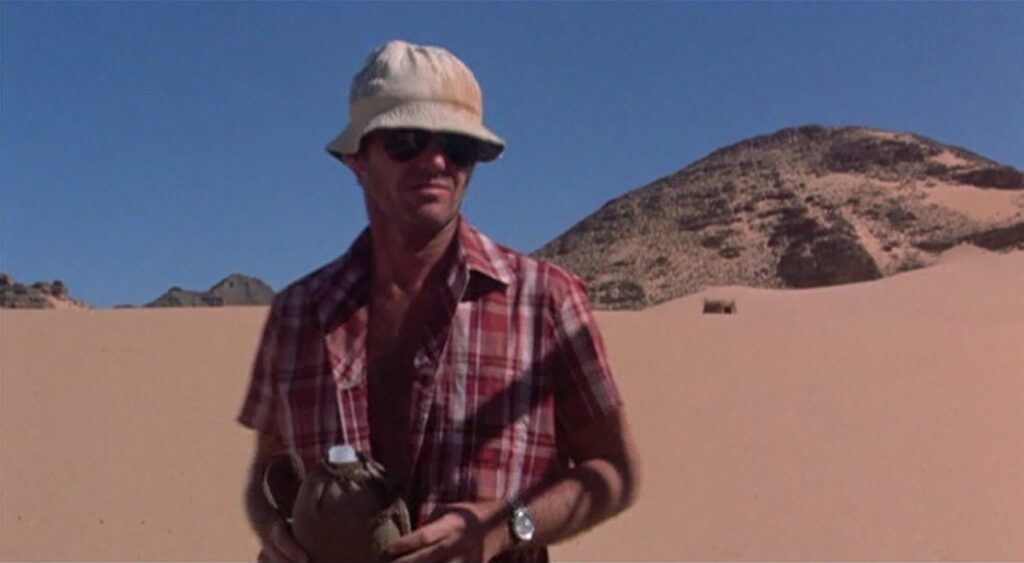
The Passenger
1975, directed by Michelangelo Antonioni
Near the end of The Passenger, David Locke tells a story about a blind man whose sight was restored in an operation. Elated at first, the man gradually grew disappointed with his newfound vision. The world was uglier and dirtier than he had imagined, and after three years he killed himself. In Antonioni’s Red Desert, Giuliana had told a similar story about a girl in the hospital, later admitting that she was the girl. We don’t need an admission to know that Locke is the blind man in his own story. In the Sahara Desert at the beginning he wears dark glasses like a blind man. He’s fed up with his life, but when he takes over David Robertson’s identity, turning from a reporter into a gun runner, the world looks new and exciting. However he quickly grows disenchanted with his new vision and proceeds willingly to his death.
Earlier when discussing Locke’s reported death on British television, Martin Knight says Locke “had this great talent for observation.” He is so far from being correct that it sounds ironic. Interviewing an African dictator, Locke was unable to challenge obvious lies. In another interview he asks an African witch doctor with unwitting condescension how he can maintain primitive beliefs after exposure to Western thought in France and Yugoslavia. The witch doctor responds by turning Locke’s camera 180º, symbolically throwing Locke’s own assumptions into question. Although Locke has won some professional respect, his frustrations make it clear that he’s been living blindly for a long time.
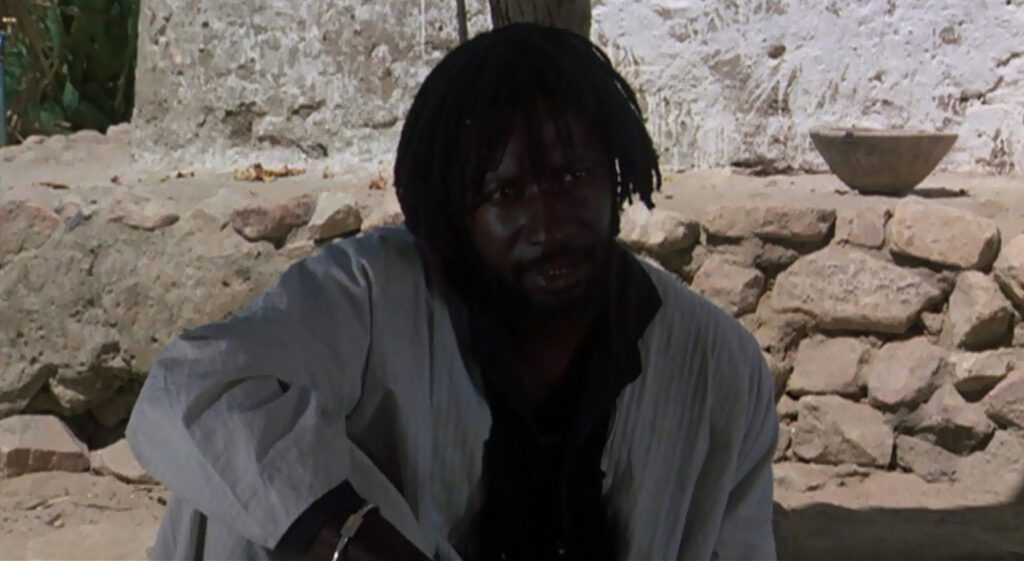
The image of a 180º change in perspective recurs a few times – not only in Locke’s new life, the blind man’s new sight, and the witch doctor’s interview, but also when Locke’s unnamed traveling companion (“The Girl” in the credits) asks him what he’s running from, and he tells her to turn her back to the front seat. Instead of seeing some ominous motivation behind the car, she gets a gorgeous view of a receding tree-lined road. Locke may have taken her question too literally, but the wonder of the view behind them indicates that he’s correct – he’s running away from life itself.
The last 180º shift comes of course in the famous six-minute thirty-second penultimate shot when the camera traverses the bars of Locke’s hotel window and winds up looking in at his dead body. The technical achievement and intricate choreography of this shot are less important than the way it leaves the protagonist’s point of view behind, making his death a small part of a much larger world that goes on without him. L’eclisse had also left its characters behind at the end with a similar purpose. Both movies aim to expand our vision by taking us beyond the limits of a single point of view. The goal of The Passenger is not to reduce Locke but to get us to see a world around him larger and more wondrous than the drama of his life story. The movie is an argument against the blind man’s conclusion that the world is ugly and dirty, but this argument cannot be made with the usual appeal to sentiment or reason. It can only appeal to experience, and it must therefore create an experience.
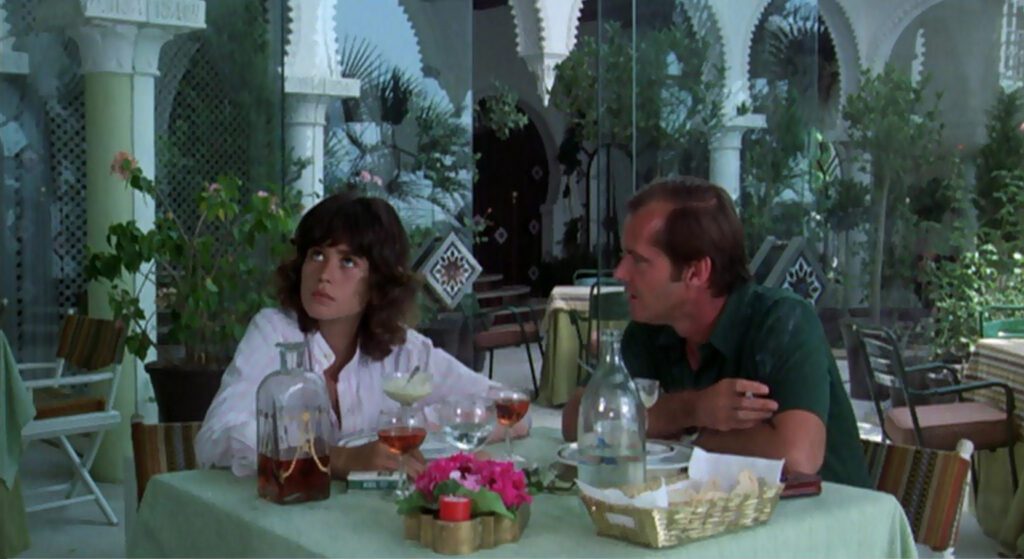
Right after the scene where the Girl watches the tree-lined road receding from the rear seat, something remarkable happens. A car whizzes by a roadside café, and the camera follows the car from left to right, landing at the table where Locke and the Girl are seated. A second car passes in the opposite direction, and for no apparent reason the camera follows that car back to the left. Then a third car passes, and once more the camera follows it, returning to the two characters. Far from being an eccentric stylistic gesture, this device reveals what The Passenger has been doing all along. Instead of simulating a world, like most movies do, where extraneous details support the plot only by adding a convincing layer of realism, The Passenger treats incidental details as if they too have importance – as if each extra and each object on the screen is part of an intersecting story. Whether it’s the three cars passing the café, the anonymous travelers greeting each other at the Munich airport, the camel driver who ignores Locke in the desert, or the actor reciting lines in the hotel dining room, the movie lingers on these as if they have as much reason to be there as any element of the narrative. The effect of this is to magnify the world, making the film worth revisiting long after the surprise of its plot has worn out.
In the flashback at the hotel in Africa, Locke admits his difficulty winning the confidence of Africans. Robertson replies, “Well, it’s like this, Mr. Locke… you work with words, images, fragile things. I come with merchandise, concrete things. They understand me straightaway.” Yet the exchange Robertson speaks of is trivial; selling guns can hardly foster a meaningful understanding. Locke is uncomfortable with the foreignness of the people he encounters, and Robertson fails to appreciate the same foreignness. The movie’s strategy is to get us to look deeply at people and things we don’t understand, because doing so fosters a sense of wonder.
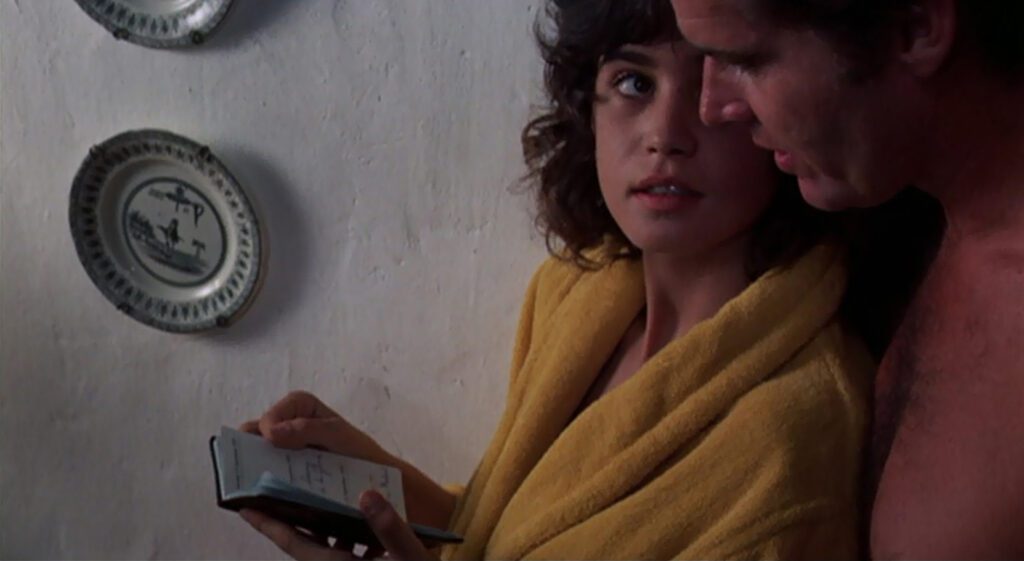
The Passenger is constructed to reward viewers who make an effort to look deeper. This reward comes not in the form of greater explanation, but rather in discoveries and connections whose meaning is often mysterious. In Munich, for example, there’s a subtle irony when a hearse leads Locke to a wedding. Cars get stuck twice, once in the desert and once in Andalucia, and each time the car shows a wisdom that Locke lacks, refusing to take him closer to his fatal destiny. There are numerous doublings and echoes: two similar-looking men named David who die face down in bed in a remote hotel, two Gaudí buildings in Barcelona, two screenings of Locke’s interview footage, and two impossible shots – the transition to the flashback in Africa, and the shot where the camera goes through the window. The Umbraculo in Barcelona echoes Robertson’s question about Umbugbene, a village in Nigeria. When the Girl spreads her arms in the back seat it echoes Locke spreading his arms in the Barcelona cable car.
Several of the cuts between scenes mask hidden links. Locke says “Yes” to the Girl before a cut to the witch doctor interview, which starts with “Yesterday”. When Locke asks the Girl what danger she’s warning him about, the answer comes in a cut to a roadside cross, i.e. death. The old man in the Umbraculo begins his life story, “One day very far from here….” and a cut takes us to an execution one day very far from Barcelona.
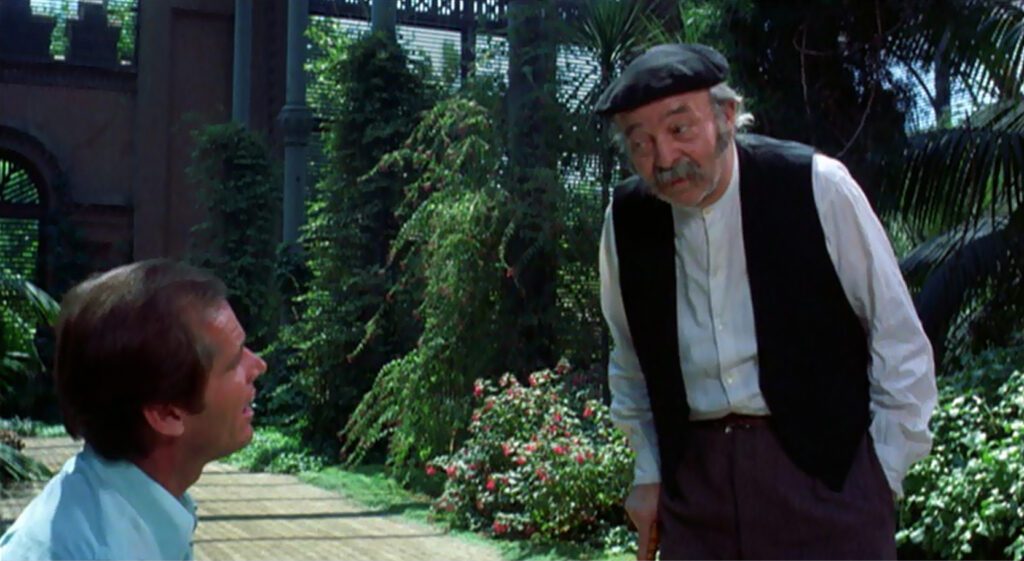
In Blow-Up, when Thomas enlarges a photograph until it reveals a gunman hidden in the trees, there’s a lesson in paying deep attention to minor details that extends to a lesson in viewing a film. The Passenger contains a similar lesson, and it alludes directly to the same scene in Blow-Up. In that famous six-and-a-half minute shot, attentive viewers may find the African gunman who kills Locke reflected in the window pane. The gunshot is likewise hidden, disguised as backfire from a nearby motor. Close inspection also reveals a likelihood that the Girl is Robertson’s wife Daisy. It can hardly be coincidence that she appears in both London and Barcelona, she shows up in the same places Robertson is scheduled to meet Daisy, and even though the receptionist in Osuna holds her passport, he still believes her name is Mrs. Robertson.
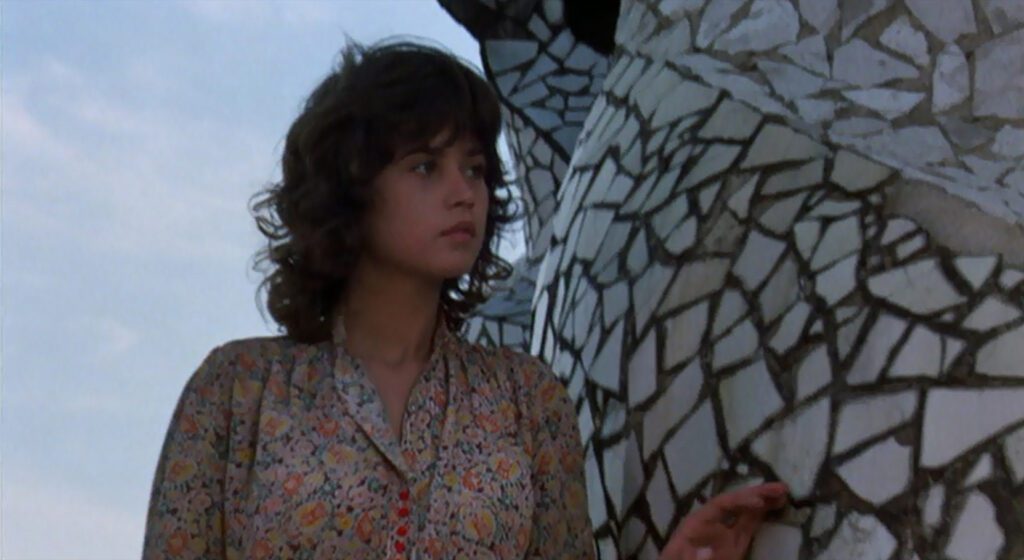
By taking the identity of an arms dealer, Locke does exactly what most people do when they watch a movie. He trades in his own life, which he finds boring, for something more dramatic. However by taking on a dead man’s identity he unwittingly accepts the dead man’s destiny. Antonioni understands that the dramatic is the enemy of wonder, and we need wonder to sustain our lives. Without it we face a figurative death similar to Locke’s literal death. In The Passenger, as in all of his movies, nearly anything dramatic is muted or cut short. The kidnapping and beating of Robertson’s contacts in Barcelona is perfunctory; the police chase on the Spanish highway is as brief as possible; instead of a love scene Locke and the Girl simply appear in long shot on a hotel bed; and Locke’s death is unseen. Dramatizing these events would interfere with looking closely because it would restrict the audience’s point of view and confine the viewer’s attention. The movie is full of references to death, but it aims to de-poeticize death. Treating death as something romantic or dramatic diminishes an appreciation of life. The Passenger, like all of Antonioni’s movies, teaches us to appreciate life better by seeing the world directly, as it presents itself, without excesses of drama or fantasy. Unlike the blind man in Locke’s story, we must escape our limited personal points of view to appreciate the wonder in everything.
CONNECTIONS:
Plein soleil – Man taking another’s identity
La notte – Dancer pours herself into a wine glass as Locke pours himself into Robertson
Knife in the Water – Protagonist tells a story that secretly refers to self in the third person
L’eclisse – Ending leaves the point of view of the protagonist(s)
Red Desert – Protagonist tells a story that is secretly autobiographical (girl in hospital / blind man)
Seconds – A man embarks on a new identity after a faked death but ends up disappointed
Blow-Up – Lesson in watching a film; hidden gunman revealed in photograph/window
The Structure of Crystal – Expressive cut that gives a wordless answer to a spoken question
Chinatown – Jack Nicholson plays a character described metaphorically or indirectly as blind
Run Lola Run – Intersecting narratives of background characters acknowledged
Dry Season – Indirect allusion to or comment on the Chadian civil wars